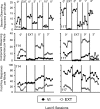Disruption of responding maintained by conditioned reinforcement: alterations in response-conditioned-reinforcer relations
- PMID: 17002227
- PMCID: PMC1592356
- DOI: 10.1901/jeab.2006.12-05
Disruption of responding maintained by conditioned reinforcement: alterations in response-conditioned-reinforcer relations
Abstract
An observing procedure was used to investigate the effects of alterations in response-conditioned-reinforcer relations on observing. Pigeons responded to produce schedule-correlated stimuli paired with the availability of food or extinction. The contingency between observing responses and conditioned reinforcement was altered in three experiments. In Experiment 1, after a contingency was established in baseline between the observing response and conditioned reinforcement, it was removed and the schedule-correlated stimuli were presented independently of responding according to a variable-time schedule. The variable-time schedule was constructed such that the rate of stimulus presentations was yoked from baseline. The removal of the observing contingency reliably reduced rates of observing. In Experiment 2, resetting delays to conditioned reinforcement were imposed between observing responses and the schedule-correlated stimuli they produced. Delay values of 0, 0.5, 1, 5, and 10 s were examined. Rates of observing varied inversely as a function of delay value. In Experiment 3, signaled and unsignaled resetting delays between observing responses and schedule-correlated stimuli were compared. Baseline rates of observing were decreased less by signaled delays than by unsignaled delays. Disruptions in response-conditioned-reinforcer relations produce similar behavioral effects to those found with primary reinforcement.
Figures




References
-
- Branch M.N. The distribution of observing responses during two VI schedules. Psychonomic Science. 1970;20:5–6.
MeSH terms
LinkOut - more resources
Full Text Sources

